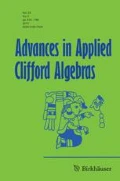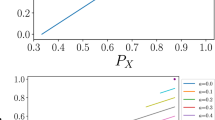Abstract
We revisit the topic of two-state quantum systems using the Clifford Algebra in three dimensions \(Cl_3\). In this description, both the quantum states and Hermitian operators are written as elements of \(Cl_3\). By writing the quantum states as elements of the minimal left ideals of this algebra, we compute the energy eigenvalues and eigenvectors for the Hamiltonian of an arbitrary two-state system. The geometric interpretation of the Hermitian operators enables us to introduce an algebraic method to diagonalize these operators in \(Cl_3\). We then use this approach to revisit the problem of a spin-1/2 particle interacting with an external arbitrary constant magnetic field, obtaining the same results as in the conventional theory. However, Clifford algebra reveals the underlying geometry of these systems, which reduces to the Larmor precession in an arbitrary plane of \(Cl_3\).


Similar content being viewed by others
References
Baylis, W.: Electrodynamics: A Modern Geometric Approach. Progress in Mathematical Physics. Birkhäuser, Boston (2004)
Baylis, W.E., Cabrera, R., Keselica, J.D.: Quantum/classical interface: classical geometric origin of fermion spin. Adv. Appl. Clifford Algebras 20(3–4), 517–545 (2010)
Bender, C., Boettcher, S.: Real spectra in non-Hermitian Hamiltonians having \(\mathscr {P}\mathscr {T}\) symmetry. Phys. Rev. Lett. 80, 5243–5246 (1998)
Cohen-Tannoudji, C., Diu, B., Laloe, F.: Quantum Mechanics. Wiley, New York (1991)
Dargys, A., Acus, A.: Calculation of quantum Eigens with geometrical algebra rotors. Adv. Appl. Clifford Algebras 27(1), 241–253 (2017)
Daviau, C., Bertrand, J.: The Standard Model of Quantum Physics in Clifford Algebra. World Scientific, Singapore (2015)
Doran, C., Lasenby, A.: Geometric Algebra for Physicists. Cambridge University Press, Cambridge (2003)
Doran, C., Lasenby, A., Gull, S.: States and operators in the spacetime algebra. Found. Phys. 23, 1239–1264 (1993)
Francis, M.R., Kosowsky, A.: The construction of spinors in geometric algebra. Ann. Phys. 317(2), 383–409 (2005)
Hestenes, D., Lasenby, A.: Space-time Algebra, 2nd edn. Springer International Publishing, Cham (2015)
Hestenes, D.: Oersted medal lecture 2002: reforming the mathematical language of physics. Am. J. Phys. 71(2), 104–121 (2003)
Hiley, B.J., Callaghan, R.E.: Clifford algebras and the Dirac–Bohm quantum Hamilton–Jacobi equation. Found. Phys. 42(1), 192–208 (2012)
Hitzer, E., Abłamowicz, R.: Geometric roots of \(-1\) in Clifford algebras \(Cl_{p, q}\) with \(p + q \le 4\). Adv. Appl. Clifford Algebras 21, 121–144 (2011)
Lounesto, P.: Clifford Algebras and Spinors. Cambridge University Press, Cambridge (2001)
Lounesto, P., Wene, G.P.: Idempotent structure of Clifford algebras. Acta Appl. Math. 9(3), 165–173 (1987)
McKenzie, C.: An Interpretation of Relativistic Spin Entanglement Using Geometric Algebra. Electronic Theses and Dissertations. 5652. https://scholar.uwindsor.ca/etd/5652 (2015)
Morais, J.P., Georgiev, S., Sprößig, W.: Real Quaternionic Calculus Handbook. Birkhäuser, Basel (2014)
Sakurai, J.J., Napolitano, J.: Modern Quantum Mechanics. Addison-Wesley, New York (2011)
Vaz, J., da Rocha, R.: An Introduction to Clifford Algebras and Spinors. Oxford University Press, Oxford (2016)
Acknowledgements
We would like to thank J. L. Bazo for his helpful comments. We would also like to thank the referees for their careful reading of the manuscript. This work was supported by the Huiracocha grant from the Graduate School of the Pontificia Universidad Católica del Perú.
Author information
Authors and Affiliations
Corresponding author
Additional information
Communicated by Eckhard Hitzer
Publisher's Note
Springer Nature remains neutral with regard to jurisdictional claims in published maps and institutional affiliations.
Appendices
Appendix
Expectation Values of Spin Vectors
The general inner product of two arbitrary algebraic spinors is given by equation (4.13)
To calculate the expectation values of spin vectors \(\mathbf{S}_i\), we set \(\Phi =\mathbf{S}_i\Psi \) in (5.1). Then for \(i=1\) this equation reduces to
therefore the expectation value of \(\mathbf{S}_1\) becomes
Expanding the algebraic spinor (4.26) \(\Psi (t)=\text {exp}(\mathbf {ie}_3\frac{\alpha }{2})\text {exp}(-\mathbf {ie}_2\frac{\theta }{2})\epsilon _+\) using Euler’s formula we have
Setting each of the coefficients of the RHS of the equation (5.4) to
therefore using (5.3) the expectation value of \(\mathbf{S}_1\) yields
In the same fashion for \(i=2,3\), we also have
Eigenvalues and Eigenvectors (an Alternative Approach)
Alternatively, in GA the eigenvalue equations (4.34) reads
If we multiply the above equation on the right by the reverse of the operator spinor \(\psi _+\) we have
since \(\psi _+\tilde{\psi }_+=1\). Now if H is a vector of \(\mathcal G_3\), then its inverse is given by \(H^{-1}=\frac{\hat{\mathbf{h}}}{|H|}\), where \(\hat{\mathbf{h}}\) is a unit vector parallel to H. If we multiply both sides of (5.13) by this inverse we have
where \(\hat{\mathbf{n}}=\psi _+\mathbf{e}_3\tilde{\psi }_+\) is a unit vector since \(\psi _+\) is a rotor. Finally squaring both sides of (5.14) we find the two eigenvalues \(\lambda =\pm |H|\). This result means that \(\hat{\mathbf{n}}=\pm \hat{\mathbf{h}} \). Therefore they are either parallel or antiparallel vectors. This means that there are two rotors \(\psi _+^1\) and \(\psi _+^2\) that bring the reference vector \(\mathbf{e}_3\) to the directions \(\pm \hat{\mathbf{h}}\). These rotors or eigenspinors correspond to the algebraic spinors (4.32) and (4.33) [5]. Additionally, writing (5.14) as \(\hat{\mathbf{h}}\hat{\mathbf{n}}=\lambda /|H|\) we see that \(\hat{\mathbf{h}}\hat{\mathbf{n}}\) must be purely scalar; this forces \(\hat{\mathbf{h}}\) and \(\hat{\mathbf{n}}\) to be either parallel or antiparallel.
Using the Hamiltonian of the example 1\(\hat{H}=a(\hat{\sigma }_1+\hat{\sigma }_3)\) we verify that the eigenvalues are \(\lambda =\pm a\sqrt{2}\). To find the two rotors \(\psi _+^1\) and \(\psi _+^2\) we can use the standard rotor formula that rotates the reference vector \({\mathbf{e}_3}\) to \(\pm \hat{\mathbf{h}}\) through an angle \(\theta \)
Since \(\hat{\mathbf{h}}=\pm \frac{1}{\sqrt{2}}(\mathbf{e}_1+\mathbf{e}_3)\) and \(\theta = \pi /4\) or \(\theta = 3\pi /4\) we find the two solutions
Two-State Quantum Systems in a Hilbert Space
Conventionally, a two-state quantum system is mathematically encoded using a two-dimensional complex Hilbert space \(\mathcal H_2\). In this space, the TSS, represented by the state vector or classical spinor \(|{\psi }\rangle \), can be written as the superposition of two orthonormal states \(|{+}\rangle \) and \(|{-}\rangle \), with complex coefficients \(c_+\) and \(c_-\):
This state vector contains all the information about the quantum system and satisfies the normalization condition \(\left\langle {\psi }|{\psi }\right\rangle =1\), implying that \(|c_+|^2+|c_-|^2=1\). Here the complex coefficients are called probability amplitudes.
On the other hand, in order to perform measurements on a quantum system, it is necessary to introduce a set of operators acting on the quantum states described by Eq. (5.18). These operators can be written as linear combinations of the following \(2\times 2\) Hermitian matrices.
Here, the identity matrix \(\hat{\sigma }_0\) together with the Pauli matrices \(\hat{\sigma }_1,\hat{\sigma }_2\), and \(\hat{\sigma }_3\) satisfy the well-known relation
which is the matrix representation of (2.11). Therefore \(Cl_3\) is isomorphic to Pauli Algebra on the real field. Consequently, any operator can be written as the sum
In addition, since \(\hat{H}\) is a Hermitian matrix, the coefficients \(h_k\), \((k=0,\ldots ,3)\) must be real numbers.
Finally, the dynamics of the state vector is described by the Schrödinger equation
where \(\hat{H}\) represents the Hamiltonian of the TSS. If this Hamiltonian is time-independent, then Eq. (5.22) shows that the state of the system at any time t can be obtained by the evolution operator \(\hat{U}=~\exp (-i\hat{H} t/\hbar )\) acting on the initial state \(|{\psi _0}\rangle \), i.e.
Rights and permissions
About this article
Cite this article
Amao, P., Castillo, H. Two-State Quantum Systems Revisited: A Clifford Algebra Approach. Adv. Appl. Clifford Algebras 31, 23 (2021). https://doi.org/10.1007/s00006-020-01116-1
Received:
Accepted:
Published:
DOI: https://doi.org/10.1007/s00006-020-01116-1




